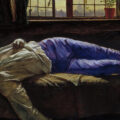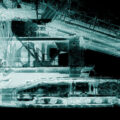With Each Breath: A Memoir of Survival

Code blue in room 241. The announcement is made in an unhurried, neutral tone. Code blue in room 241. I push my food away, jump up, heave open the heavy break room door, and begin to run. It’s not a full on sprint. I’ve seen some do that. Still, I’m making good time, up the humid stairwell, and down the hallway toward the intensive care unit. Other people are running too. A quick rush of feet across the polished floor plays like a fashion show for athletic footwear. Nurses in Reebok, Saucony, and Mizuno buzz around, their mesh and rubber brightly colored.
When I arrive in the ICU, it is already a frenzied scene. A nurse hurries around the corner with a crash cart. An intensivist rushes in and out of the room, pulling the yellow curtain closed, looking worried. I move to head of the bed and begin delivering oxygen with a resuscitation bag. A pair of emergency room techs trade off on chest compressions, while a silver-haired unit coordinator stands by the door, keeping track of which medications are given, and when. After three rounds, we pause to check for a pulse. Everyone is quiet as the intensivist places two fingers over the patient’s femoral artery. She shakes her head, and our voices rise again as we resume compressions.
Though the name Respiratory Therapist may evoke images of deep breathing while floating along a clear mountain stream, it is neither a distant branch of yoga nor a school of meditation. My adventures in respiratory therapy had an innocuous start. I wouldn’t readily admit this in a job interview, but I actually had no idea what I was signing up for. What does a respiratory therapist do? I asked the guidance counselor, a sober-looking man with a porcelain Dachshund on his desk. I had worked as a short order cook, a substitute preschool teacher, and most recently, an advocate for the developmentally disabled. I was enrolled in the worker-retraining program, and the most crucial aspect of my new chosen profession, whatever it may be, was that it fit snugly into the “demand” column of the Employment Security Department’s database. Noticeably absent from the list of “in demand” occupations were the things I might have wanted to be: writer, musician, artist.
I was nineteen years old and living in a college town about fifty miles away from our suburban Detroit home when I got the phone call from my father.
Like everyone else in Detroit, my father worked in the automotive industry. He was a vice president of a manufacturing company that supplied seat upholsteries and bumpers to the big three automakers. It’s different than being the vice president of, say, a national bank, or a retail-clothing conglomerate. The automobile industry has been in sharp decline for decades. If you’ve ever been to Detroit, you may have seen the abandoned Fisher Plant, a place where they once churned out Cadillacs by the thousand, now a pile of geometric rubble. Both my mother and father bore witness to Detroit’s decline, from riots in the sixties to increasing reliance on foreign manufacturing in the seventies.
Vice president or not, my father’s voice quivered on the other end of the phone, and I knew something was very wrong. No, your mother is okay, he told me, it’s your brother. He shot himself.
The roots of modern day respiratory therapy began during the polio outbreak of Copenhagen in 1952 when, after running out of iron lungs, a few hundred chipper Danish medical students were forced to keep patients alive by manually pushing air into their lungs. Polio, or poliomyelitis, is a virus that causes swelling of the spine and, in severe cases, respiratory paralysis and death. Children were mostly afflicted. The Danish medical students worked around the clock, in six to eight hour shifts, brushing the blonde hair from their eyes, squeezing a rubber bag attached to a breathing tube. Their method, utilizing positive rather than negative pressure—the principal behind the iron lung—worked better than anticipated. Many lives were saved. The polio epidemic of 1952 is credited as a major turning point in the fabled history of respiratory therapy. Soon after, the positive pressure ventilator, or modern day life support system, came to replace the iron lung.
In our lab at the community college where I studied to become a respiratory therapist, there was a lavishly restored iron lung dating from the 1950s. We used it to keep our potato chips fresh. One day, I climbed inside while another student turned on the pressure. I had the claustrophobic sensation of being unable to see my arms and legs, while a pressure pulled against the cavity of my chest. It was not a pleasant sensation.
People would ask, when I used to talk about it, whether my brother and I were close. We had drifted apart in our teenage years. I had no other siblings and we were just one grade apart, and we were close when we were younger. But high school for my brother was a series of public embarrassments from which he withdrew, embarking on a succession of high school relationships far too serious for his age. When he wasn’t with his girlfriend, he moodily listened to headphones around the house.
There were other signs early on. Instead of collecting baseball cards, he collected the hood ornaments of neighborhood cars. Instead of wind sprints at soccer camp, he outran security guards at Target. After my brother’s suicide, my mother liked to say that he wasn’t really a bad kid, he just always got caught. But I’m here to dispute that. There was plenty that he got away with.
The other question I got a lot, when I still talked about it, was if my brother was depressed. It’s a legitimate question. Obviously, if someone takes their own life, they feel like there are no remaining options. But was my brother depressive growing up? Despite the acting out, I feel like the answer is no—it was not a dominant part of his personality. If anything, I’m more inclined toward depression than he was, and I don’t think I am alone in that assessment. After his funeral, the rumor going around our small suburban town was that it was me who had committed suicide, not him.
I’ve heard it called the cabbage patch. It’s a cruelly apt description for a facility where many of the patients are in a persistent vegetative state. The walls of the cabbage patch are chipped and faded. The dirty hallway carpet carries the overpowering scent of industrial strength cleaning detergents. It’s the last stop for those who need care for the rest of their lives, unfortunate souls for whom the charity hospital no longer had a bed. Some stayed only a few months before their time came. They were kept comfortable with boluses of morphine and a clean bed. One patient dying of throat cancer received regular infusions of malt liquor in his IV. He had been at the facility for over a year, and could tell the difference between Cobra and other, lesser brands.
Other patients had been at the facility for seven, eight, even a dozen years. Those were the ones in a persistent vegetative state. They lived in an unknowing gray, oblivious to their surroundings, unaffected by the passage of time. A few received regular visitors. Most didn’t. Their loved ones had moved on. Stories about the patients were passed down among the staff. One man was repairing his truck when it collapsed on top of him. Another ingested a kilo of cocaine while being chased by the police. One soap opera–handsome fifty year old in a persistent vegetative state was shanked in the jugular during a prison yard scrap. We didn’t know the truth of any of these stories. Because the facility used paper charting, the original patient history was often obscured, locked away in storage in the basement of the building.
A frequently repeated anecdote belonged to one of the facility’s oldest residents. Though the details varied, it was agreed that the patient had once worked at the facility—a nurse’s aide or in the kitchen. He was an alcoholic, the story went, with poorly managed diabetes, and one morning, after he failed to show up to work, a nurse was dispatched to his home, where she found him frothing at the mouth in front of the TV, wearing only his briefs. She called first responders, but it was too late, anoxic brain injury had already occurred. The irony wasn’t lost on me: work here too long, and you may never leave.
Every patient in the cabbage patch was in the process of dying. There were a lot of half-heads: men and women with large parts of the skull removed to compensate for swelling. Sometimes, once the swelling subsided, the body would reject the once-removed portion of the skull. It wouldn’t be a stretch to imagine my brother like that. Failed suicides passed through the doors of our facility on a regular basis. While I worked at the cabbage patch, I never let myself to wonder what if, but the question persisted. I imagined the cavernous subterranean room where bone fragments were kept, frozen, waiting to be reclaimed.
At some point a new shower aide was hired. In addition to bathing his patients, this new aide gave them stylishly manicured facial hair. A svelte mustache appeared here, a goatee there. Doughy and baby faced, some of the men looked like current day Backstreet Boys. Others resembled landed gentry or oil barons from a bygone era. Everyone looked better, more life-like, with a little facial hair. Suddenly, they looked as if they had been active participants in their lives. The daughter of one patient came in nearly every day after work. She talked to her father cooingly, embraced him, left little stuffed bears beneath his giant calloused hands. He looks so handsome now! she said of his formidable mustache. I had to agree. He could command a great ship with a mustache like that.
My brother and his friends would ride around the suburbs of Detroit with a sawed-off shotgun in the hatchback of a rusted Ford Escort. They took the gun to the woods a few times, to shoot at the trees, and one day there talked of robbing a liquor store. Teenage bravado. The proximity to Detroit guaranteed that even the lankiest suburbanites talked tough, sometimes.
After graduation, my brother attended culinary school, and the gun was stowed away in a dark corner of his closet. He visited his girlfriend—a nice, typical Midwestern girl—at her college every weekend and on most holidays. He moved into his own apartment in nearby Ypsilanti, a city best known for being not as bad as Detroit. One year after my brother, I left home for the football-obsessed farm town where I chose to further my education.
While I was away, my brother’s life began to unravel.
His girlfriend broke up with him, and he dropped out of culinary school. At the restaurant where he was a kitchen manager, he was demoted, then abruptly walked out. My brother began phoning his ex-girlfriend late at night, accusing her of cheating. Unable to manage car payments and rent, he moved back in with my parents. The harassing calls to his ex-girlfriend continued. He enrolled in community college and found a job as a short order cook. He spent long evenings with my mother and father, and our grandmother, who lived nearby, then went to see his best friend and gave away some of his possessions.
When he decided to shoot himself, my brother walked off into the woods just a quarter mile away from our parent’s home. My mother was shopping for a Thanksgiving turkey. My brother smoked a cigarette and drank a can of beer before putting the gun in his mouth. His body was found the following day, lying by a stream.
At the morgue, it was my grandmother who came to identify him. My parents shared the burden of phoning friends and family. It was a closed-casket funeral. We had the chance to see him one more time before the other guests arrived, but I didn’t go in to the viewing room with my parents. I couldn’t.
For many years I have had a recurring dream. My brother survived his suicide, but he is not the same. He is disfigured, or unable to speak, and sometimes it isn’t even that he tried to kill himself, but that he has been in some terrible accident. Almost immediately, I regretted not seeing my brother’s body. My mother reassured me, that he didn’t resemble himself. Only his hands were recognizable. But I began to feel that my inability to heal was due, in part, to this choice.
At the funeral, both my brother’s ex-girlfriend and the friend who gave him the gun were present. The girlfriend could only stand with the help of a cousin. She was unable to face my mother. Much later, I learned that she was worried my brother planned to take her out with the shotgun, too. The good friend was similarly distraught, and would struggle with his own drug problems and suicide attempts over the years.
It didn’t really matter where the gun came from. The note my brother left behind was similarly insignificant: a neatly printed apology on a scrap of paper. The note offered nothing.
After my brother’s death, my mother claimed to communicate with him from beyond the grave. She said he explained why he’d done it (he was sensitive) and dispensed generic health advice (eat less red meat, exercise more). She received these messages as a clear voice she was able to tune into like an AM radio. These otherworldly dispatches often arrived late in the evening, after she had had a few drinks, as she was attempting to light a cigarette. It was a confusing consolation at best.
The spring after his suicide, we traveled to Arizona, exploring large pockets of the state in an economy rental car. As we traversed the desert highway from flagstaff to the Grand Canyon, my mother looked over her shoulder and says to me, I can see your brother, sitting beside you, staring out the window. Did she literally mean he was there with us in the car? Or perhaps this was just a scene, the family car ride, that had played out so many times that it was hard not to imagine him, headphones on, moodily contemplating the passing cacti. I didn’t press her for a distinction.
After withdrawing from college and moving back in with my parents, I began a course of psychotropic drugs, including an anti-psychotic medication that caused me to sleep for whole days at a time. My medicated dystopia was not quite broken up by working the third shift at a nearby gas station. I had no real plan, returning to our family home. I was becoming a burden to my parents. The mood of the house was quietly oppressive and the phone never rang, at least not for me. If an old acquaintance came to buy gas or cigarettes at my service station I attempted to make casual, anti-psychotic small talk. I found it difficult to hold a conversation. Not that I was particularly effusive before, but I seemed to have developed a tick, physically wincing when I felt another person’s gaze settle upon me.
It wasn’t just my brother’s voice that my mother heard. The room could become crowded with them. In our carpeted den, a procession was taking place. One voice spoke in elegant, almost poetic generalities about an entrance to the spirit world; another claimed to have beaten a man to death. My mother was nonplussed. At my insistence, she attempted to conjure the ghost of John Lennon, her adolescent hero. She closed her eyes and, while attempting to light a menthol, dredged up the spirit of some unenthusiastic Englishman.
There will be times when you will need to put your emotions aside, the instructor warned us. When you get home, talk about it with your wife, with your husband. You will need to talk—but in the moment, when it’s happening, you have to be focused on your job.
Our code blue is a sixty-eight year old woman who arrived the previous night on a flight from Guanajuato, Mexico. She is here visiting her three grown sons who work as day laborers. She awoke early in the morning and was cooking eggs and bacon for them on the stovetop range when she collapsed. They found her crumpled on the linoleum floor.
The doctors try to maintain a sterile field as the entire bed shakes from chest compressions. The room is warm with the heat of many bodies in motion. Her sons had not seen her for several years. Now they wait just outside as doctors attempt to place an IV line in her femoral artery. Her heartbeat returns, for a moment, then quickly fades.
This happens several times over the course of an hour. Each time, I press the code blue button, sending another overhead message heard throughout the hospital, and we resume chest compressions.
Despite the efforts of so many talented people, the patient is not responding. Her sons watch us perform a last round of chest compressions and deliver the requisite dose of drugs. Finally, they’re invited to hold their mother’s hand. In Spanish, they beg her to stay. When she passes, the eldest son begins to wail, and it can be heard throughout the intensive care unit.
A few years after my brother’s suicide, my mother committed herself to a psychiatric ward. She was not allowed visitors or phone calls. On long distance calls with my father, my consistent refrain was should I fly home? My father didn’t think it was a good idea. There was no point in disrupting my life. There was little I could do to help.
Her illness began with symptoms like a stomach flu. Weeks of being unable to finish a meal, or even leave the house, took a psychological toll. In bed all day, no longer taking the anxiety medication she had been happily abusing for years. Doctors were unable to find physical maladies, but she had withdrawn. It wasn’t my mother’s first hospitalization. A previous breakdown occurred while I was in high school; at the time, she stayed in the psych ward for over a month after experiencing symptoms of a dissociative disorder, characterized by the sensation of being outside of one’s own body. This time, the various medications offered no relief, and being in the hospital only increased her feelings of isolation, separating her from reality.
It wasn’t long before she agreed to a round of electroshock therapy. My mother was transferred to a new hospital for the procedure. I had not spoken to her in over a month. Her first electroshock treatment went smoothly, with even a noted lightening of her mood, but something went wrong on the morning of her second. My father called just as I was getting ready to go to work, and I knew right away, from the sound of his voice, that something was very wrong. I’m coming home. The next morning, I flew to Detroit at a bereavement rate. There was a full autopsy, a lawsuit, and later a small settlement. But it didn’t matter any more than the gun.
To survive in a place where death is the norm, a certain type of gallows humor often exists. After one code blue that ended badly, the staff coped by commenting on the deceased’s pristine tan line. I’d die for a body like that, one nurse joked. It’s not pretty, but it’s healthier than the alternative. In traumatic situations, people devolve into their eight-grade selves. They’re desperate to laugh.
Another code, and all I know prior to arrival is that the patient was found hanging in a rented storage facility; when I see them, it’s worse than I imagined. At first, I think the patient is a teenaged boy, and time seems to halt. As I put on gloves and prepare to take over breathing from the medic, though, I see that it is actually a woman in her late forties or early fifties. She is pretty, though small and ragged, as if suicide were a final choice in a series of failures.
Loved ones will emerge in the ICU, and a painful story will take shape. But she won’t survive. Soon, her heart will stop, the code blue button will be punched, and ten more people will flood into the room. CPR will continue in the same workmanlike manner. Nurses will exchange concerned glances. Techs will stop their compressions, and people will disperse. A cart will be wheeled down. I will see the cart as I am walking with my coworker, and I will buy him a coffee in the cafeteria.
What does a respiratory therapist do? Let me tell you what a respiratory therapist does not do. A respiratory therapist does not walk the halls of hospital sobbing hysterically. A respiratory therapist does not vomit into a trashcan at the sight of blood. A respiratory therapist does not have panic attacks. While I’m at the hospital I’m mostly able to keep my feelings at bay. Mostly. I get home from work each evening, I turn out the lights, and begin to dream. Sometimes, I dream I’m in an iron lung, all glossy yellow and chrome, like a Cadillac. I hold my breath just a little longer each time. Other times, I dream of the triathlete who came into our ED, his ribs chipped and cracked, his chest sinking in—rather than expanding—with each breath.
About James Smith
James Smith is a Seattle based writer, musician and animator. He is currently working on a book of short stories.





